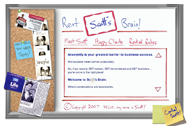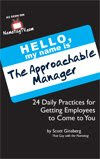 Businesses that get talked about GET more business.
Businesses that get talked about GET more business.
Period.
And if people aren’t actively telling their friends about you, your products and your services, they don’t exist.
Period.
Enter “spreadability.”
No, this has nothing to do with Ritz Crackers.
THE SECRET IS: You can’t “go viral” or “get people to start talking about you.”
What you CAN do is create an environment in which word of mouth is most likely to occur.
And you do that by making your message more spreadable.
Here are eight ways to do so:
1. Sell without selling. Spreadability is the result of subtly pitching your product in SUCH an entertaining way that customers never feel like they’re being sold. Joe Pulizzi from The Content Marketing Revolution wrote, “Stop thinking about pushing your product and start thinking about what your customers would do after engaging in your marketing. If the inclination is to spread the message, then you’ve done something right.” Are you SO good that people will voluntarily sign up to watch your marketing?
2. Think like a doctor. Marketers should hang out with doctors. Not because marketers are sick (even though some people might argue otherwise), but because there’s some overlap between the two disciplines. For example: “You can’t spread a disease that’s dormant.” That’s a medical truth. Interestingly, the word “dormant” comes from the Latin dormire, which means, “to sleep.”
Here are my questions: Which of your marketing efforts are asleep? Which of your marketing efforts are putting customers TO sleep? And who in your marketing department needs to wake up FROM their sleep? “Paging Dr. Bankruptcy, Dr. Bankruptcy. You have a patient waiting in Surgery 2.” How dormant is the disease you’re trying to spread?
3. The flu has feelings too. As cyberculture journalist Douglas Rushkoff suggested, “People don’t engage with each other to exchange viruses; people exchange viruses as an excuse to engage with each other.” And often times, they do so unintentionally.
And, as social networking blogger Izzie Neis explained, “From a marketers perspective, if you can engineer the perfect viral campaign, the people will be powerless to resist. They’ll be diffusing your ideas before they know what hit them.” How could you spread your virus to people without them even knowing, but without them even caring that they have it?
4. Reward the spreaders. Provide an incentive for users, customers, readers and viewers to spread your content. Give away freebies. Offer samples. Maybe even allow customers to tally a scorecard for every time they spread your idea. You could even structure an incentive system based on the customer’s number of “spread points,” much like airlines miles. Whatever it takes to ensure people truly believe they have something to gain by spreading the message. Because if they don’t, they won’t. What carrot can you dangle in front of your spreaders noses?
5. Sticky is for suckers. Sticky doesn’t necessarily mean viable. Spreadable, on the other hand, is powerful AND profitable. Henry Jenkins, Director of Comparative Media Studies at MIT, wrote a fantastic article on spreadability in 2009. He explained: “In the era of convergence culture, spreadable content is designed in a way to be circulated by grassroots intermediaries who pass it along to their friends or circulate it through larger communities.”
Lesson learned: Surrender control. Enable people to take YOUR idea into THEIR own hands. Openly embrace a “fan” mentality and transfer ownership to the customer. Find people that have big mouths, market to them – give them megaphones – then get out of the way. That’s how spreadability becomes long-term viability. Are you (truly) spreadable, or just sticky?
6. Unspreadable is the enemy. Ever tried to spread refrigerated butter? It’s near impossible. You almost always puncture a hole in the bread, right? Not exactly an efficient way to make a sandwich. Interestingly, in my research on spreadability, I came across an article from the Journal of Thermal Analysis and Calorimetry. It’s called, Melting Properties of Butter Fat, The Consistency of Butter and The Effect of Modification of Cream Ripening and Fatty Acid Composition.
Fascinating stuff. According to the Hungarian professors who wrote the piece, there is a close relationship between the consistency of butter and its product characteristics:
“The cold, unspreadable consistency of butter after taking it out of the refrigerator is a rightful objection on behalf of consumers. And it can only be improved by the combination of the heat-step cream ripening and enrichment with low melting point triglycerides to achieve stable consistency at room temperature.”
Now, if you’re like me, you probably have no idea what the hell that means. But stay with me here. Because this article proves, scientifically, that spreadability is directly related to high quality ingredients. And that doesn’t just go for butter. In marketing, the same principle applies:
Shtick isn’t enough – you’ve got to support remarkability with substance.
Otherwise customers aren’t going to tell their friends about you. What does your product have going for it that surpasses baseline remarkability?
7. Medium AND message. As Duncan Watts says in the bestselling Six Degrees, “The structure of the network is perhaps more important in predicting the spread of content than the nature of the content.” Lesson learned: Viral marketing is a social animal. So, whatever message you’re spreading, don’t just focus on the content – but on the needs of the people you’re asking to spread that content. What do your followers crave?
8. Propagation planning. “Plan not for the people you reach, but for the people they reach,” says Griffin Farley, noted spreadability thought leader. That’s the central idea behind propagation planning, something I recently learned about from reading Griffin’s blog.
I also learned about propagation planning from Ivan Pollard, who said:
“Plant the message or bits of the message in various places in such a way that people pull the entire message or components of the message down. Let them play with the stuff you give them. Get involved with it. Package it back up again in a way that reflects their take on it (even if it is just adding a comment), then pass it on to people in their network or circle.”
In the process of doing this, says Ivan, the message gets stronger and more powerful as it moves on – not weaker and more fragmented. Think mash-up. Think parody videos. Are you forgetting about your customer’s customer?
REMEMBER: If you don’t spread – you’re dead.
Now if you’ll excuse me, all this talk about being spreadable is making me hungry.
I see a box of Ritz Crackers in my future.
LET ME ASK YA THIS…
How are you boosting your spreadability?
LET ME SUGGEST THIS…
For the list called, “123 Questions Every Salesperson Should Ask,” send an email to me, and you win the list for free!
* * * *
Scott Ginsberg
That Guy with the Nametag
Author, Speaker, Coach, Entrepreneur
[email protected]
 Need to build your Thought Leadership Platform?
Need to build your Thought Leadership Platform?
Perhaps my monthly (or yearly) coaching program would help.
Rent Scott’s Brain today!












